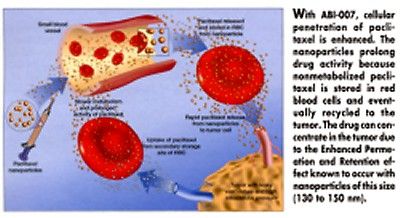Nanoparticle Paclitaxel Promising in Metastatic Breast Cancer
ORLANDO-ABI-007, an alternative, Cremophor-free intravenous paclitaxel (Taxol), developed using nanoparticle technology, provided pronounced single-agent efficacy in two multicenter phase II trials in metastatic breast cancer, according to data presented at the 38th Annual Meeting of the American Society of Clinical Oncology (abstract 209). In preclinical studies, ABI-007 resulted in significantly less toxicity than paclitaxel (abstract 462).
ORLANDOABI-007, an alternative, Cremophor-free intravenous paclitaxel (Taxol), developed using nanoparticle technology, provided pronounced single-agent efficacy in two multicenter phase II trials in metastatic breast cancer, according to data presented at the 38th Annual Meeting of the American Society of Clinical Oncology (abstract 209). In preclinical studies, ABI-007 resulted in significantly less toxicity than paclitaxel (abstract 462).
The novel cytotoxic agent, currently under study in a phase III trial, is a nanoparticle, albumin-stabilized paclitaxel. The nanoparticles have an average size of 130 to 150 nm, or about 1/80th the size of a red blood cell.
To date, ABI-007 has been administered to nearly 300 patients, many at higher doses than is standard with Taxol therapy, yet all patients were treated without steroid premedication and, in the majority of cases, without G-CSF (Neupogen), Patrick Soon-Shiong, MD, told ONI in an interview. In addition, the infusion is given over 30 minutes, compared with the standard 3-hour Taxol infusion.
There has been no evidence of anaphylaxis, and researchers have noted "reduced myelosuppression," compared to what might be expected with Taxol, so that G-CSF support was generally not needed, said Dr. Soon-Shiong, chairman and CEO of Los Angeles-based American Pharmaceutical Partners, which is developing ABI-007. "I am hopeful that this lack of serious hematologic toxicity and potential increased efficacy will change the course of how taxane therapy is given," he said. "If one could give a higher dose safely, there is a potential then for achieving a higher response rate."
ABI-007 is just one current strategy for overcoming limitations of current taxane delivery methods, notably those limitations attributed to the vehiclea 1:1 mixture of Cremophor EL and dehydrated ethanol. Cremophor vehicle has been associated with a variety of pharmaceutical concerns, including serious hypersensitivity reactions.
According to Dr. Soon-Shiong, the nanoparticles prolong the activity of the parent molecule because nonmetabolized paclitaxel is stored in red blood cells and eventually recycled to the tumor. Additionally, the drug can concentrate in the tumor due to the Enhanced Permeation and Retention (EPR) effect known to occur with nanoparticles of this size. Thus, ABI-007 provides a protein-engineered biological nanotransporter mechanism for enhanced cellular penetration of paclitaxel (see Figure).

It has not been well recognized that in addition to the toxicity effect, the Cremophor solvent entraps the paclitaxel molecule within the plasma, resulting in reduced tissue and tumor availability of the active compound. The enhanced cellular penetration afforded by ABI-007 may account for the safety and efficacy effects reported in this phase II study.
Dr. Soon-Shiong said that the company’s preclinical research shows that, after 24 hours, the amount of nonmetabolized nanoparticle paclitaxel is double that of Taxol (44% vs 22%). "Metabolism is slower, because ABI-007 has been stored in red cell depot," he said.
Preclinical data (abstract 462) showed significantly lower toxicity with ABI-007 than Taxol in five human tumor xenografts in athymic nude mice of varying sensitivity to the drug. In all five studies, the maximum tolerated doses of ABI-007 were between 1.5- and 3.4-fold greater than those of Taxol.
Response Rates
The phase II data in patients with metastatic breast cancer showed an overall response rate of 61% (7% complete responses) at the maximum tolerated dose of 300 mg/m² and 51% (7% complete responses) at a lower dose (175 mg/m²), with an objective response rate (complete response plus partial response) of 88% in patients receiving 300 mg/m² as first-line therapy. In addition, there was a statistically significant decrease in the time to first response at 300 mg/m².
Response rates for patients who had prior anthracycline were 55% and 60%, respectively, for the high- and low-dose ABI-007 groups. A response was noted in two of nine patients who had prior taxane therapy, all at the higher dose. One patient who had demonstrated Taxol resistance and failed FAC (fluorouracil, Adriamycin, cyclophosphamide), radiotherapy, Taxol, liposomal doxorubicin (Doxil), and gemcitabine (Gemzar) achieved a complete response following eight cycles of ABI-007 at 300 mg/m².
The adverse events noted in the study for 175 and 300 mg/m², respectively, were grade 4 neutropenia 7% and 22%, grade 3-4 neuropathy 0% and 13%, grade 3-4 stomatitis 0% and 2%, and grade 3-4 rash 0% and 2%.
The results suggest that ABI-007 is "an efficacious and well tolerated agent for metastatic breast cancer," the investigators, led by Dr. N.K. Ibrahim, of M.D. Anderson Cancer Center, said at their ASCO poster. The senior author was Gabriel N. Hortobagyi, MD, chairman, Breast Medical Oncology.
The ongoing phase III trial of ABI-007, which will enroll between 400 and 600 metastatic breast cancer patients, compares Taxol 175 mg/m² given over 3 hours every 3 weeks with nanoparticle paclitaxel at below the maximum tolerated dose (260 mg/m²) given over 30 minutes every 3 weeks with no steroid premedication and no G-CSF. The goal is to show noninferiority to Taxol on response rate, efficacy, and safety.